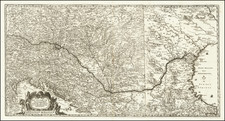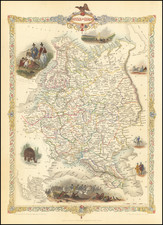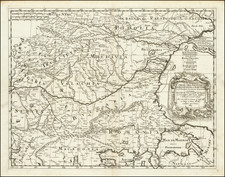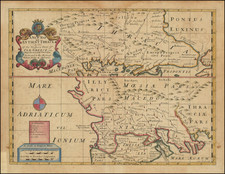Exceptional Old Color Example
Finley executed battle plan illustrating the positions of the Russian, Moldovan and Ottoman troops during the 4 day battle of Stănileşti in July 1711.
The battle followed a joint Russian-Moldovan invasion of this Ottoman controlled region in retribution for the Sultan Ahmed III's sheltering of Charles XII of Sweden following the Swedish King's defeat at Poltawa.
The key at the bottom left explains in Dutch the various positions of the combatants.
Pruth River Campaign (1710-11)
The Russo-Ottoman War of 1710–1 1or Pruth River Campaign began following Russia's victory over Sweden in the Battle of Poltava and the escape of the wounded Charles XII of Sweden and his large retinue to the Ottoman-held fortress of Bender. Sultan Ahmed III gave shelter to the Swedish King, prompting Peter the Great of Russia to attack the Ottoman Empire, which in its turn declared war on Russia on in November 1710.
Several months later, in April 1711, Prince Dimitrie Cantemir of Moldavia and Peter the Great signed the Treaty of Lutsk, by which Moldavia pledged to support Russia in its war against the Ottomans, providing troops and allowing the Russian army to cross its territory and place garrisons in Moldavian fortresses.
After having gathered near the Moldavian capital Iași, the combined Russian-Moldovan army moved southward in July 1711 along the Prut River with the intention of crossing the Danube and invade the Balkan peninsula.
The main battle was the four-day Battle of Stănileşti (beginning on 18 July 1711), an ill-prepared operation on the Prut floodplain during which the joint Moldavian and Russian troops, the former under the command of Cantemir and the latter under Peter the Great and Boris Sheremetev, were surrounded and forced to surrender to the larger Ottoman army commanded by Grand Vizier Baltacı Mehmet Pasha.
As the Russo-Moldavian army moved along the Prut, a portion of the Russian army under General Carl Ewald von Rönne moved towards Brăila, a major port town located on the left bank of the Danube (in Wallachia) but administered directly by the Ottomans as a kaza. The Russian army met with a portion of the Wallachian army commanded by Spatharios (the second-highest military commander after the Prince) Toma Cantacuzino, who disobeyed the orders of the Prince Constantin Brâncoveanu and joined the Russians. The two armies assaulted and conquered Brăila after a two-day siege
The conflict ended on July 21, 1711 by the Treaty of the Pruth, returning Azov to the Ottomans; several Russian fortresses were to be demolished; and Peter agreed to stop interfering in the affairs of the Polish-Lithuanian Commonwealth.
The Ottomans also demanded that Charles XII be granted safe passage to Sweden and asked Peter to hand over Cantemir. Although Peter acquiesced to all demands, he refused to fulfill the latter, under the pretext that Cantemir had fled his camp.
Rarity
The plan is very rare. OCLC locates 3 examples: Koninklijke Bibliotheek, Erasmus University Rotterdam, University of Groningen.
Nicolaas Visscher II (1649-1702) was a prominent Dutch cartographer and publisher during the late 17th century. He was the grandson of Claes Janszoon Visscher and the son of Nicolaes Visscher I, both of whom were also renowned cartographers in their own right. After his father's death in 1679, Nicolaas Visscher II took over the family's map publishing business.
In 1680, he married Elizabeth Verseyl from Gouda, and in 1682, he obtained a new privilege from the States of Holland and West Friesland to protect his maps and publications from being copied. Visscher II continued the family tradition of producing high-quality maps, atlases, and globes, often with elaborate and decorative elements. He maintained the Visscher family's reputation for accuracy and craftsmanship in the competitive world of Dutch cartography until his death in 1702. After his death, his widow, Elizabeth, and later his son, also named Nicolaas, continued the business until around 1726.










![[ Southern Moldova ] Des Furstenthums Moldau Sudliche Haelfte Nro. 9](https://storage.googleapis.com/raremaps/img/small/101964.jpg)



![Sarmatia Utraque Europaea et Asiatica [Ancient Russia from both Europe and Asia]](https://storage.googleapis.com/raremaps/img/small/82027.jpg)